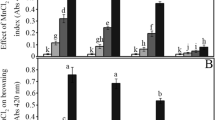Abstract
Eight winged bean seed varieties were treated by two methods, autoclaving and soaking, to investigate their respective effects on the antinutritional behenic acid in winged bean seeds. Either method was not able to completely destroy behenic acid. Thirty minute autoclaving reduced the behenic acid content up to 5%, and 60 min autoclaving reduced by 15%. Soaking in water in 2 h did not make any change in behenic acid content in any of the varieties, while 20 h soaking reduced it by 1.5%.
Similar content being viewed by others
References
Anonymous (1978) The winged bean: 1st International symposium, Manila, Philippines
Claydon A (1975) A review of the nutritional value of the winged bean,Psophocarpus tetragonolobus L. DC, with special reference to Papua New Guinea. Sci New Guinea 3:103–114
Brown WH (1954) Useful Plants of the Philippines. Manila Bureau of Printing, pp 160–162
Cerny K, Kordylas F, Pospisil F, Svabensky O, Zajic B (1971) Nutritive value of the winged bean (Psophocarpus palustries Desv.) Brit J Nutr 26:293–299
Kapsiotis GD, (1968) Chemical analyses on winged beans. F.A.O. Press, Rome
Hidlitch TP, Williams PN (1964) The Chemical Composition of Natural Fats. Chapman and Hall, London
Chan J, de Lumen BO (1982) Properties of trypsin inhibitor from winged bean (Psophocarpus tetragonalobus) seed isolated by affinity chromatography. J Agric Food Chem 30:42–46
Chan J, de Lumen BO (1982) Biological effects of isolated trypsin inhibitor from winged bean (Psophocarpus tetragonalobus) on rats. J Agric Food Chem 30:46–50
Khor HT, Tan HT, Wong KC (1980) The winged bean (Psophocarpus tetragonolobus). Proc Malays Biochem Conf 6:157–164
Kritchevsky D, Tepper SA, Vesslinovitch D, Wissler RW (1973). Cholesterol vehicle in experimental atherosclerosis. Part 13. Randomised peanut oil. Atherosclerosis 17:225
Bean G, Fernando T, Holden M, Patterson G (1984) Total plant analyses of sterols and fatty acids of the winged bean (Psophocarpus tetragonolobus). J Food Sci 49:964–965
Fernando T, Bean G (1985) A comparison of the fatty acids and sterols of seeds of weedy and vegetable species ofAmaranth spp. J Am Oil Chem Soc 62:89–91
Fernando T, Bean G (1984) Fatty acids and sterols ofAmaranthus tricolor L. Food Chem 15:233–237
Schertz KF, Boyd WC, Jugesky W, Cabanillas E (1960) Seed extracts with agglutinating activity for human blood, Econ Bot 14:232–240
Author information
Authors and Affiliations
Rights and permissions
About this article
Cite this article
Fernando, T., Bean, G. The reduction of antinutritional behenic acid in winged bean (Psophocarpus tetragonolobus L. DC) seeds. Plant Food Hum Nutr 36, 93–96 (1986). https://doi.org/10.1007/BF01092136
Issue Date:
DOI: https://doi.org/10.1007/BF01092136




